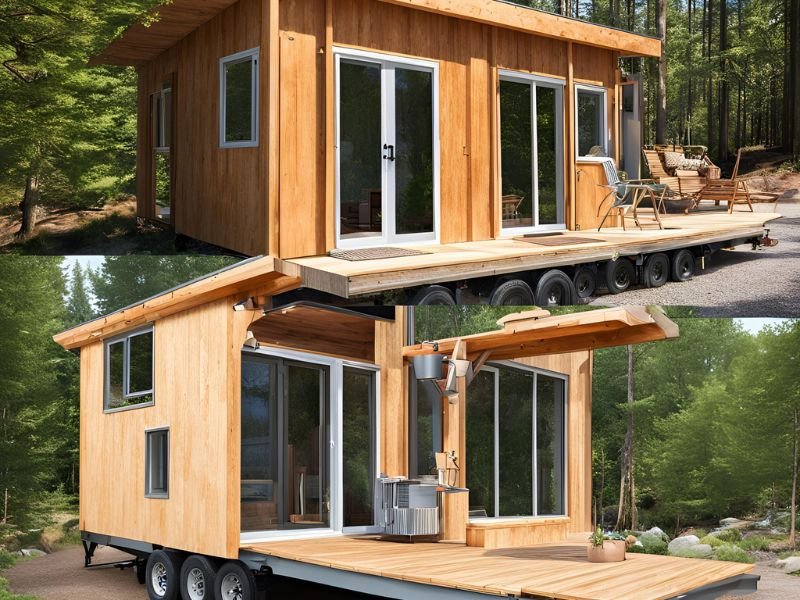When building a sustainable tiny home, maximize space usage with vertical storage and multi-functional furniture. Opt for eco-friendly materials like recycled timber and solar panels for energy efficiency. Design with passive solar features, effective insulation, and water conservation methods like rainwater harvesting. Incorporate renewable energy sources like solar panels and wind turbines. These tips will create an environmentally friendly and cozy living space.
Key Takeaways
- Maximize storage with vertical space and multi-functional furniture.
- Choose eco-friendly materials like recycled timber and opt for solar panels.
- Incorporate passive solar design and effective insulation for energy efficiency.
- Implement rainwater harvesting and greywater recycling for water conservation.
- Prioritize renewable energy sources like solar panels and wind turbines for sustainable power.
Efficient Use of Space

When designing your sustainable tiny home, focus on maximizing every square foot to guarantee efficient use of space.
To achieve this, prioritize maximizing storage by utilizing vertical space with shelves and cabinets. Opt for multi-functional furniture such as sofa beds, foldable tables, or storage ottomans that serve dual purposes without taking up extra room.
Consider installing built-in furniture like benches with hidden storage compartments or beds with drawers underneath. Customizing your furniture to fit the specific dimensions of your tiny home will help you make the most of the available space.
2. Eco-Friendly Materials Selection
To enhance the sustainability of your tiny home, consider selecting eco-friendly materials that align with your values and contribute to a more environmentally conscious living space. Opt for recycled timber for flooring, cabinetry, and furniture. Recycled timber reduces the demand for new wood, helping to preserve forests and lower carbon emissions.
Additionally, integrating solar panels into your tiny home can greatly decrease reliance on non-renewable energy sources. Solar panels harness sunlight to generate electricity, reducing your carbon footprint and energy bills. By choosing materials like recycled timber and solar panels, you not only create a more sustainable living environment but also promote a greener lifestyle in your tiny home.
3. Energy-Efficient Design Strategies
Looking to maximize energy efficiency in your tiny home construction?
Incorporating passive solar design and effective insulation techniques can greatly reduce your energy consumption.
Passive solar design involves strategically placing windows to allow sunlight in during the winter months for natural heating, while overhangs block the sun during summer to prevent overheating.
Additionally, utilizing insulation techniques such as spray foam insulation, insulated concrete forms, or double-stud walls can help maintain a comfortable indoor temperature year-round by minimizing heat transfer.
4. Water Conservation Techniques
Consider implementing efficient fixtures and practices to minimize water usage in your sustainable tiny home construction. Two effective water conservation techniques for your tiny home are rainwater harvesting and greywater recycling. Rainwater harvesting involves collecting rainwater from your roof into storage tanks for later use in activities such as watering plants or flushing toilets. On the other hand, greywater recycling refers to reusing water from sinks, showers, and laundry for purposes like irrigation or toilet flushing. By incorporating these methods into your tiny home construction, you can greatly reduce your water consumption and environmental impact. Check out the table below for a quick comparison of rainwater harvesting and greywater recycling:
| Rainwater Harvesting | Greywater Recycling |
|---|---|
| Collects rainwater for later use | Reuses water from sinks, showers, and laundry |
| Ideal for activities like watering plants | Suitable for purposes like irrigation or toilet flushing |
| Helps reduce water consumption | Aids in minimizing wastewater disposal |
5. Sustainable Power Sources
When exploring sustainable power sources for your tiny home construction, prioritize renewable energy options for long-term efficiency and environmental benefits.
Consider installing solar panels on your tiny home’s roof to harness the power of the sun and convert it into electricity. Solar panels are a reliable and eco-friendly way to generate electricity for your home, reducing your reliance on traditional power sources.
Additionally, integrating wind turbines into your tiny home construction can further enhance your renewable energy capabilities. By harnessing the wind’s energy, wind turbines can supplement your power needs and contribute to a more sustainable lifestyle.
Embracing these sustainable power sources guarantees that your tiny home operates efficiently while minimizing its impact on the environment.
Conclusion
To sum up, building a sustainable tiny home isn’t only environmentally friendly but also cost-effective. Did you know that using eco-friendly materials can reduce carbon emissions by up to 20%?
By incorporating efficient space utilization, eco-friendly materials, energy-efficient design, water conservation techniques, and sustainable power sources, you can create a tiny home that’s both comfortable and environmentally responsible.
Start your tiny home construction journey today and make a positive impact on the planet!
